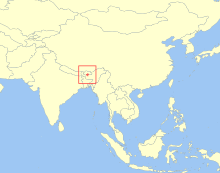Golden langur
| Gee's golden langur | |
|---|---|
 |
|
| Scientific classification | |
| Kingdom: | Animalia |
| Phylum: | Chordata |
| Class: | Mammalia |
| Order: | Primates |
| Family: | Cercopithecidae |
| Genus: | Trachypithecus |
| Species: | T. geei |
| Binomial name | |
|
Trachypithecus geei (Khajuria, 1956) |
|
 |
|
| Gee's golden langur geographic range | |
Gee's golden langur (Trachypithecus geei), or simply the golden langur, is an Old World monkey found in a small region of western Assam, India and in the neighboring foothills of the Black Mountains of Bhutan. It is one of the most endangered primate species of India. Long considered sacred by many Himalayan people, the golden langur was first brought to the attention of the western world by the naturalist E. P. Gee in the 1950s. In a part of Bhutan, it has hybridised with the capped langur T. pileatus.
The earliest record of the golden langur is in Pemberton's 1838 paper which states that "Griffith observed these monkeys near Tongso in Central Bhutan." However, Pemberton's work was lost and not rediscovered until the 1970s, the scientific discovery of the golden langur unfolded differently. In 1907, E. O. Shebbeare—who was out with some hunters and forest rangers—reported seeing a "cream coloured langur" in the vicinity of the Jamduar. However, neither a photograph nor a live or dead specimen was presented at that time. The first reference to the golden langur in print, as an animal of unidentified taxonomic status, was in a 1919 publication that stated: "Pithecus sp? – A pale yellow coloured langur is common in the adjoining district of Goalpara (Assam). Jerdon reported one from Terai, the adjacent district on the (west) side, which Blanford suggested might be P. entellus."
At around the time of India's independence in 1947 a number of other sightings were reported. In February 1947, in the Forest Rest House visitor's book in Raimona, a few miles south of Jamduar, C. G. Baron reported seeing some langurs whose "whole body and tail is one colour – a light silvery-gold, somewhat like the hair of a blonde." A year later, back in Jamduar, H. E. Tyndale, a tea planter, reported seeing "Sankosh cream langurs." However, it wasn't until a few years later that a focused effort to identify the golden langur was mounted by E. P. Gee, who traveled to Jamduar in November 1953. His team were able to observe three groups of golden langurs, all on the east bank of the Sankosh river. The first group was observed on the Bhutan side of the border; the second group, a large one of 30 to 40 individuals, a mile north of Jamduar on the Indian side; and a third group four to five miles (6.44 km to 8.05 km) south near Raimona. Colour movies of the second group were made by Gee.
...
Wikipedia

